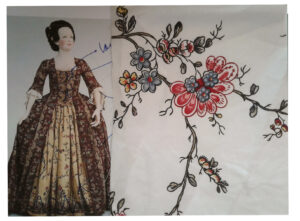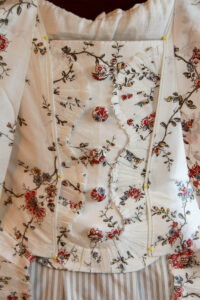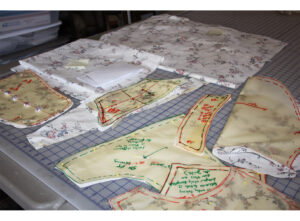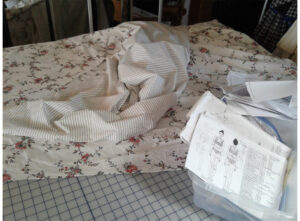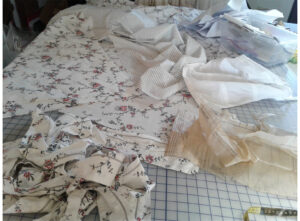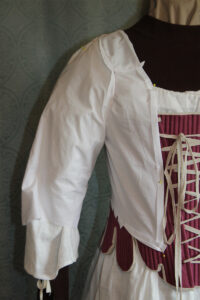
Susan Hurlbutt, Time Traveler End of Journey
1950’s Blouse, Petticoat, & Rump
1776 Pomegranite Bodice
1770’s Robe a l’anglaise & Paniers

Like Susan’s 1745 projects, these are based on the “Outlander” romance book and mini-series, where Claire (Fraser) begins a time traveling journey in Scotland right after the World War in 1945, and goes back to 1745 Scotland. Many inches of paperback or years of depiction on the big screen later, Claire and Jamie end up in Colonial America during the Revolutionary War. While a sequel is in the works to go into the 1780’s, this depiction ends with the main series in 1776-1778.
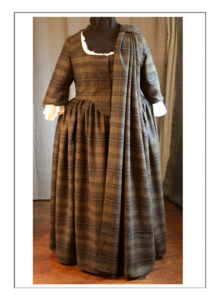
Susan already has her clan tartan wedding gown (based on Isabella McTavish), and her mix and match wool brown and blue bodice and petticoats like Claire wore every day and throughout the early parts of the show. These new garments are a bit more “modern” (as in 1770’s instead of 1740’s) and American (textiles from America rather than Scotland, etc.)
In one of the Season 5 episodes, Claire is living in Boston, Massachusetts when she learns that back in Scotland 1765, the love of her life is still alive. She makes out of a 1960’s raincoat, girdle, and dress a modern version of an 18th Century ensemble. She steals her daughter’s handkerchief linen blouse.
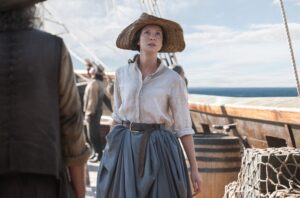
In the subsequent shows after meeting up with Jamie again in Colonial America, Claire wears various gorgeous gowns to events where they “scope out the bad guys”. They spend time with an Aunt who has a lot of money, and Claire is beautifully dressed for events in Virginia. Susan supplied the plaid linen for the petticoat, and a printed cotton Williamsburg floral pattern fabric for the gown (“robe” – see the history pages for explanations1740-1780 Colonial Specific of different types of “robesl”
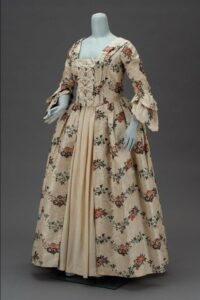
These projects complete Susan’s full time travel by taking her 1745 “healer” ensemble into the 1770’s. She already has the appropriate undergarments, and we’ve done the research already, so the challenge was to recreate garments similar to what Claire would wear in different places and for different events.
The first is a cotton/linen handkerchief 1960’s blouse which Susan will wear for every day as well as with her historic garments. Of the same design, fabric, and notions as Claire’s 1960 version, this one is actually made from a 1970 vintage pattern which includes a 2022 modern swing as a tunic. Susan will be able to wear this under her 18th century petticoat, or with modern leggings for every day. She can wear it over modern undergarments, the 1890’s corset we made her, just a camisole, or over her stays.
The plaid linen petticoat is made to go with the blouse. It is the basic garment for eras 1745-1780, and this one features special construction so it can go to a “raw” (uncorseted, no stays) body to one tightly cinched at the waist. (We don’t care about the hips – they’ll be hidden by the tunic or petticoat no matter what). The difference is that the waist tie in an 18th c petticoat is usually static, meaning it is custom built in the width of the front waistband and the back waistband with just the right amount to overlap and make a pocket slit.
This petticoat has a casing instead of a static waistband, but is basted in the center so it can’t pull out and so it has a stabile center point to hold up the heavy large amount of fabric to keep it from drooping center front and back even though it’s not the usual rigid and strong twill tape of a basic middle class Colonial garment.
This first ensemble is what Claire wore on the ship to Jamaica and when she was shipwrecked on a tropical island. Our favorite scene is when she burned her bum roll to keep warm. In the show, that pad had been made in the 1960’s, so was of modern cotton fabric. Ours is a more modern fabric than would have typically been used in the 1770’s also. Ours is a pillow or mattress ticking, which is a strong canvas with indigo stripes. Indigo would definitely be common and cheap, and not draw attention to a garment made in the 1900’s to blend in the 1700’s. We can’t remember, but Claire might have made hers from a pillowcase.
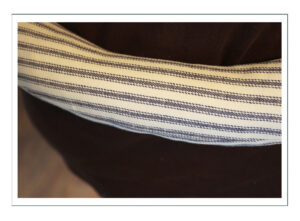
Our bum roll is a small one for the figure, so it can be worn in modern situations, but it still must be worn because the pleating will hang wrong without it, and the skirt will drag 3″ in the back. Sorry, Susan, but there must be some concessions to historical accuracy, and anyway, a big booty is very much in style today.

Plaid Linen Petticoat
with Cotton Ticking small Bum Roll
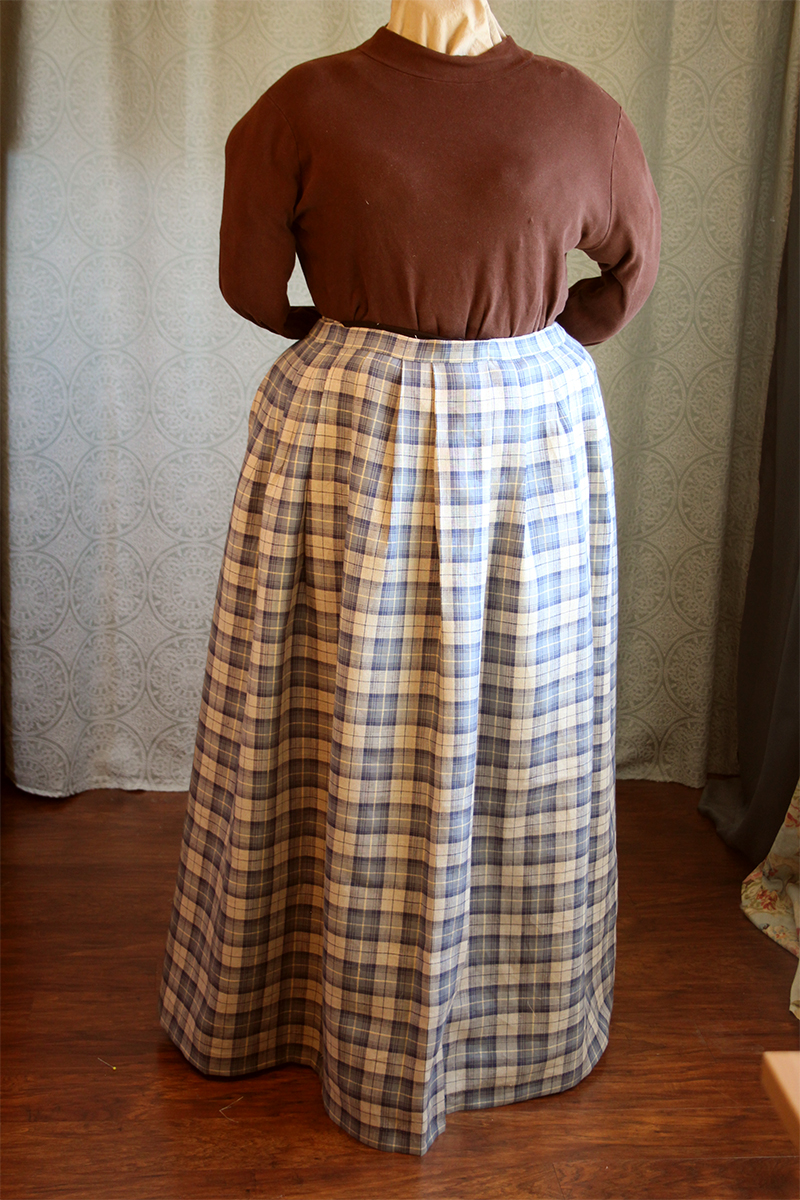
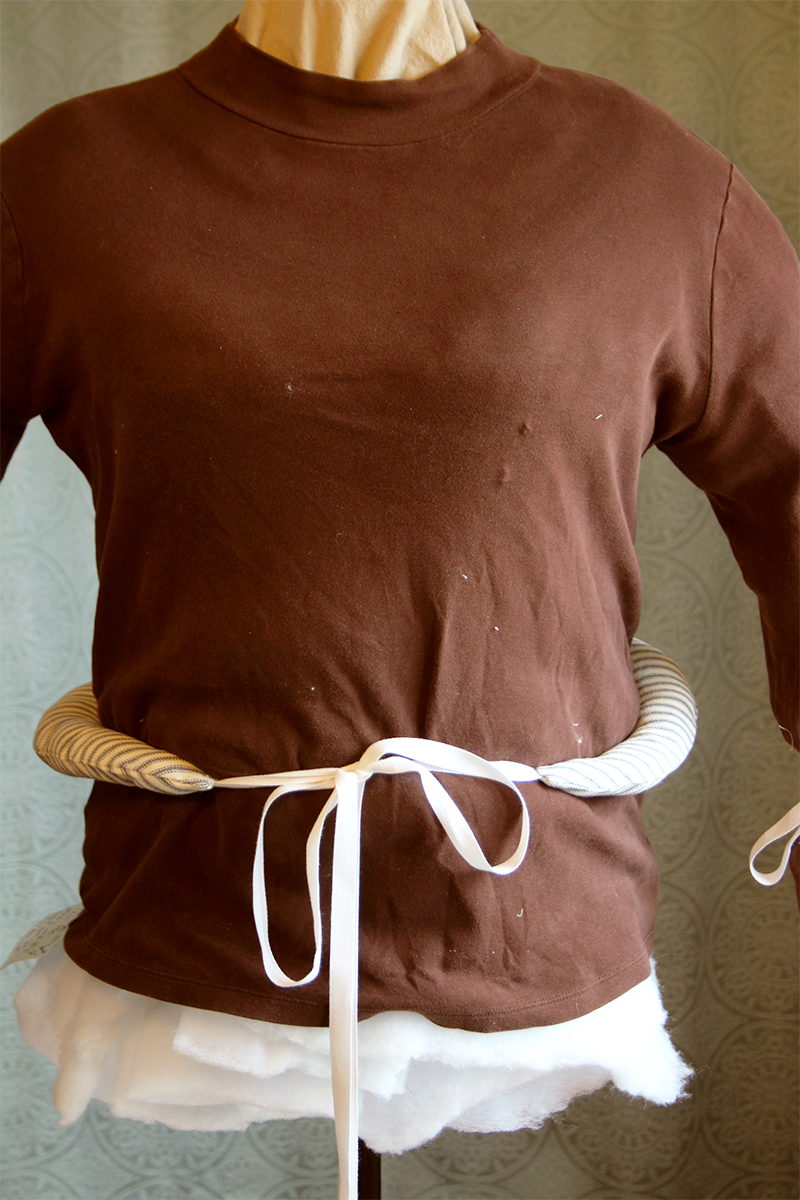
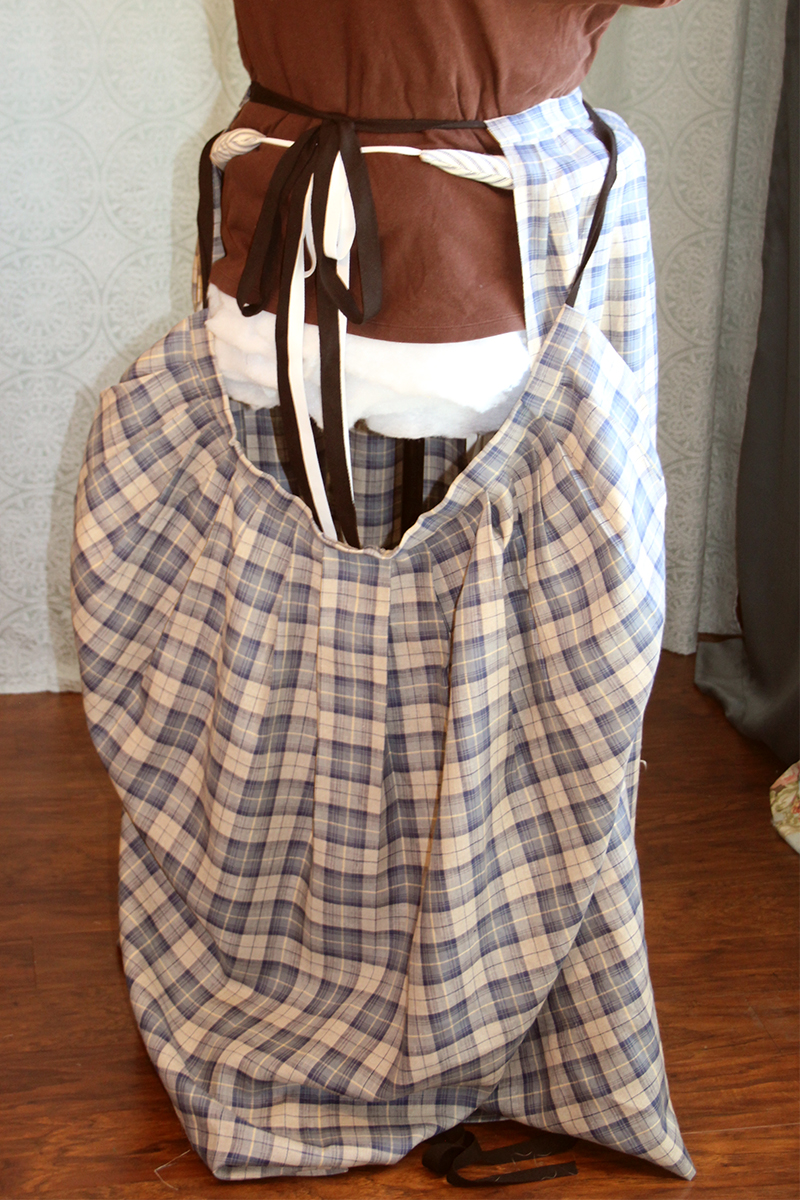
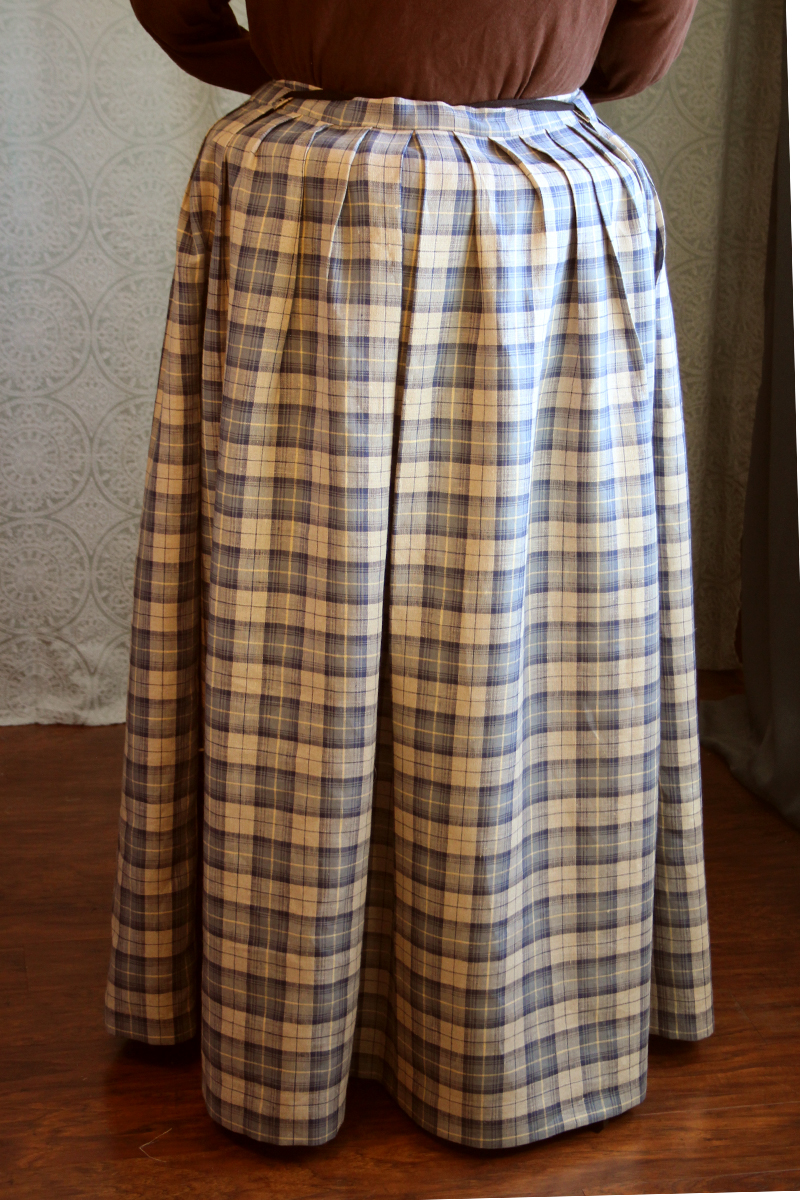

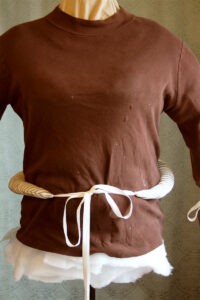
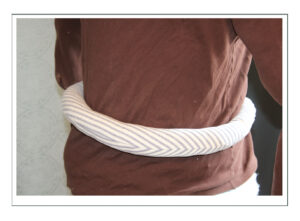
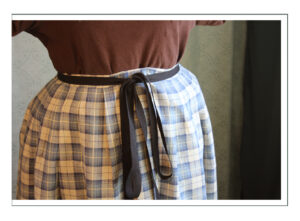
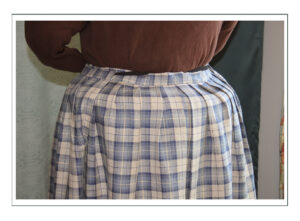
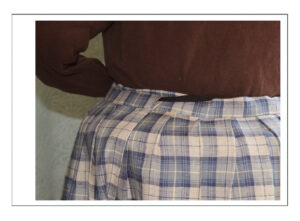
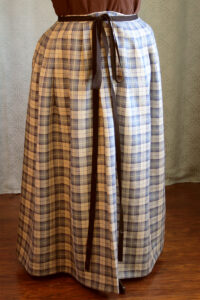
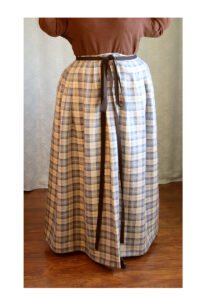
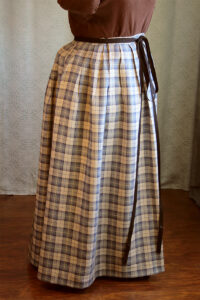
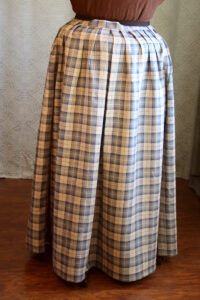
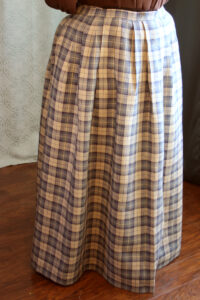
Modern Linen/Cotton Blouse
to go with Plaid Petticoat or Leggings
A 2012 pattern. What an adventure to make a modern garment.
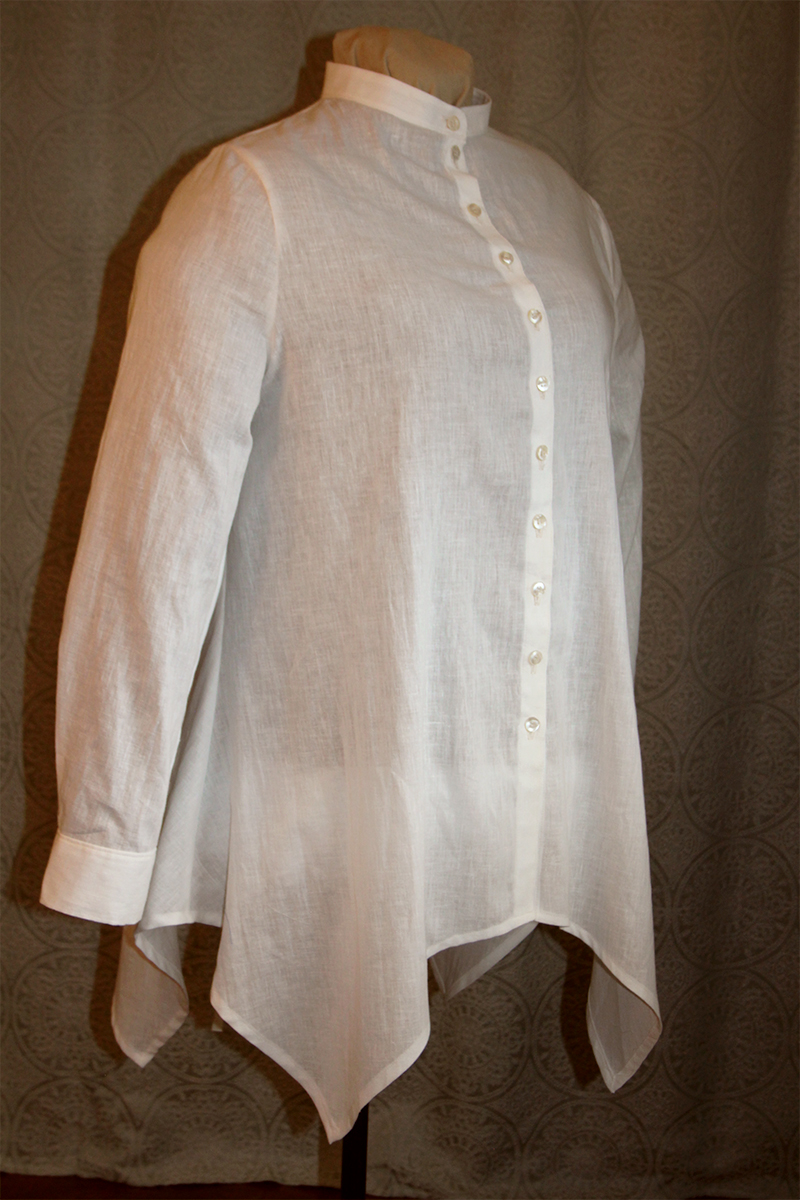
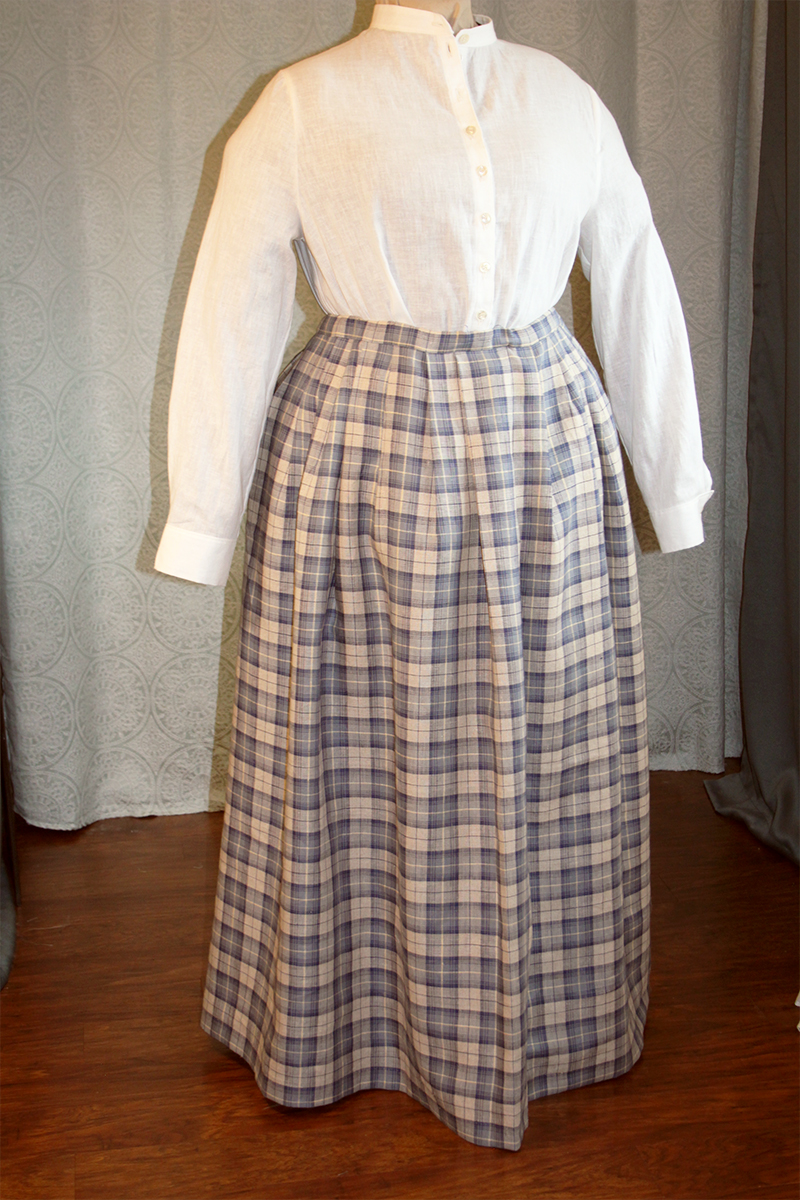
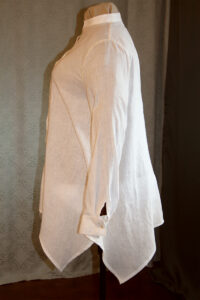
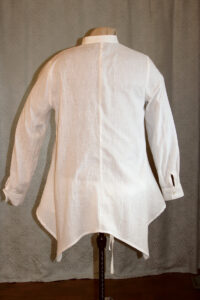
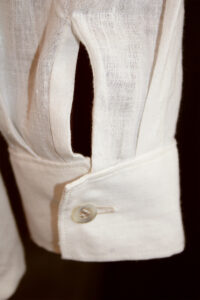
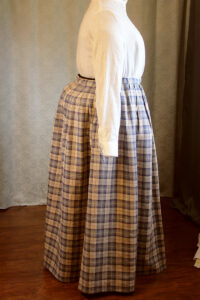
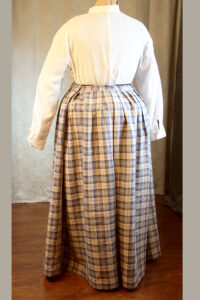
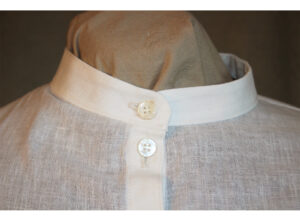
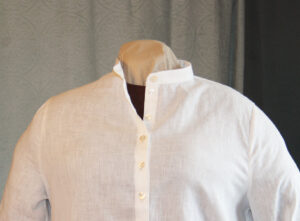
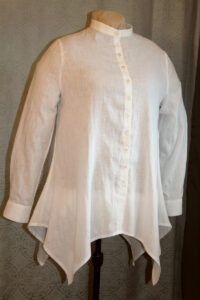
1776 Blue Bodice
to complete the mix and match of earlier ensembles
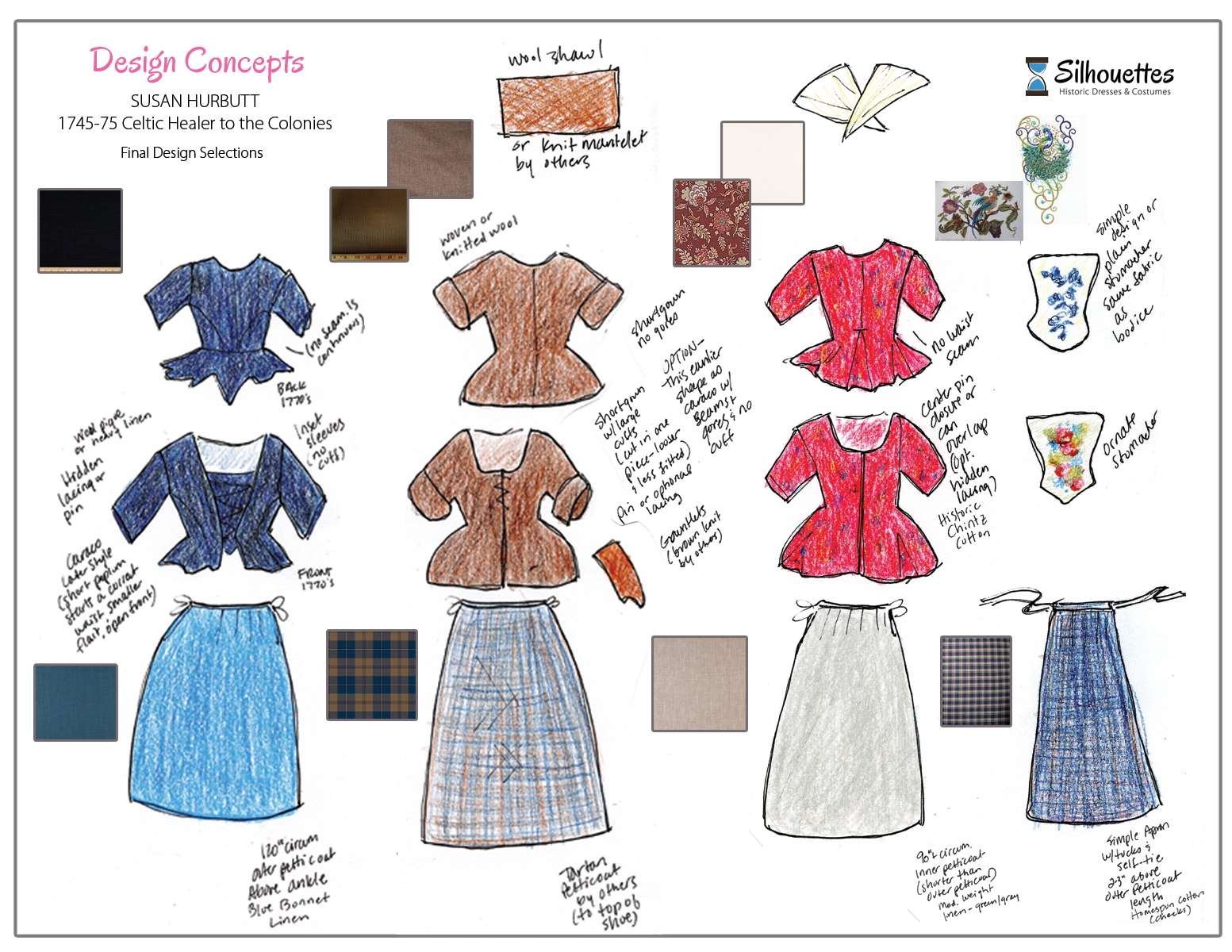
This is our 3rd attempt at fit on this project. For design development, see the duplicate project on Suzi 1776 Mantua-maker. It is of beautiful indigo blue pomegranite India printed cotton, such as would be imported to the Colonies from India. It is historical reproduction fabric, and also imported today.
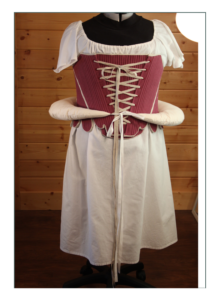
The design features a bit higher neckline was standard at the time so Susan can wear it with modern undergarments, although the peplum is designed for her large bum roll. The small bum roll pad shown is because Susan has her big one, and we just had this and the mannequin available in her raw size. You’ll note there is room in the back for her stays which will be larger than raw measurements.
This goes with her blue linen skirt, natural apron, and ivory fichu. Cording is cotton and it is fully lined with a heritage sateen cotton which means very softe but also very dense and the whole project is very durable. We added hip gores that were not on the historical pattern design to accommodate the fullness of the large bum roll.
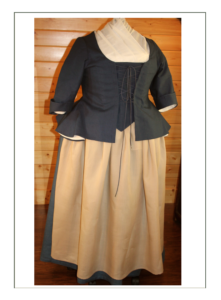
This differs from Susan’s other bodices in the narrow, pointed center back which rises above the natural waistline and is indicative of the 1770’s rather than her other ones which are 1740’s-1760’s. The very low neckline is also a later mid-century feature.
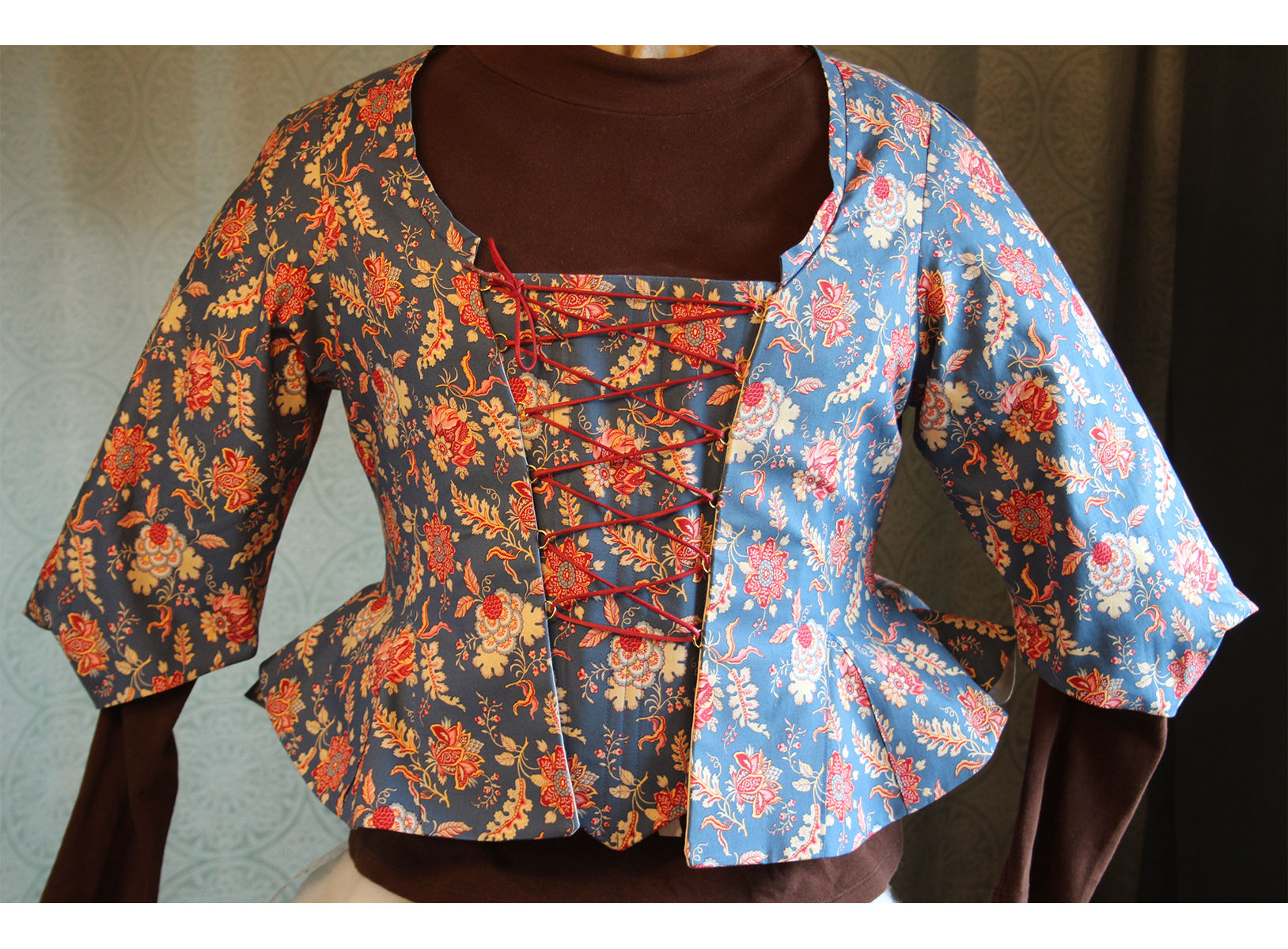
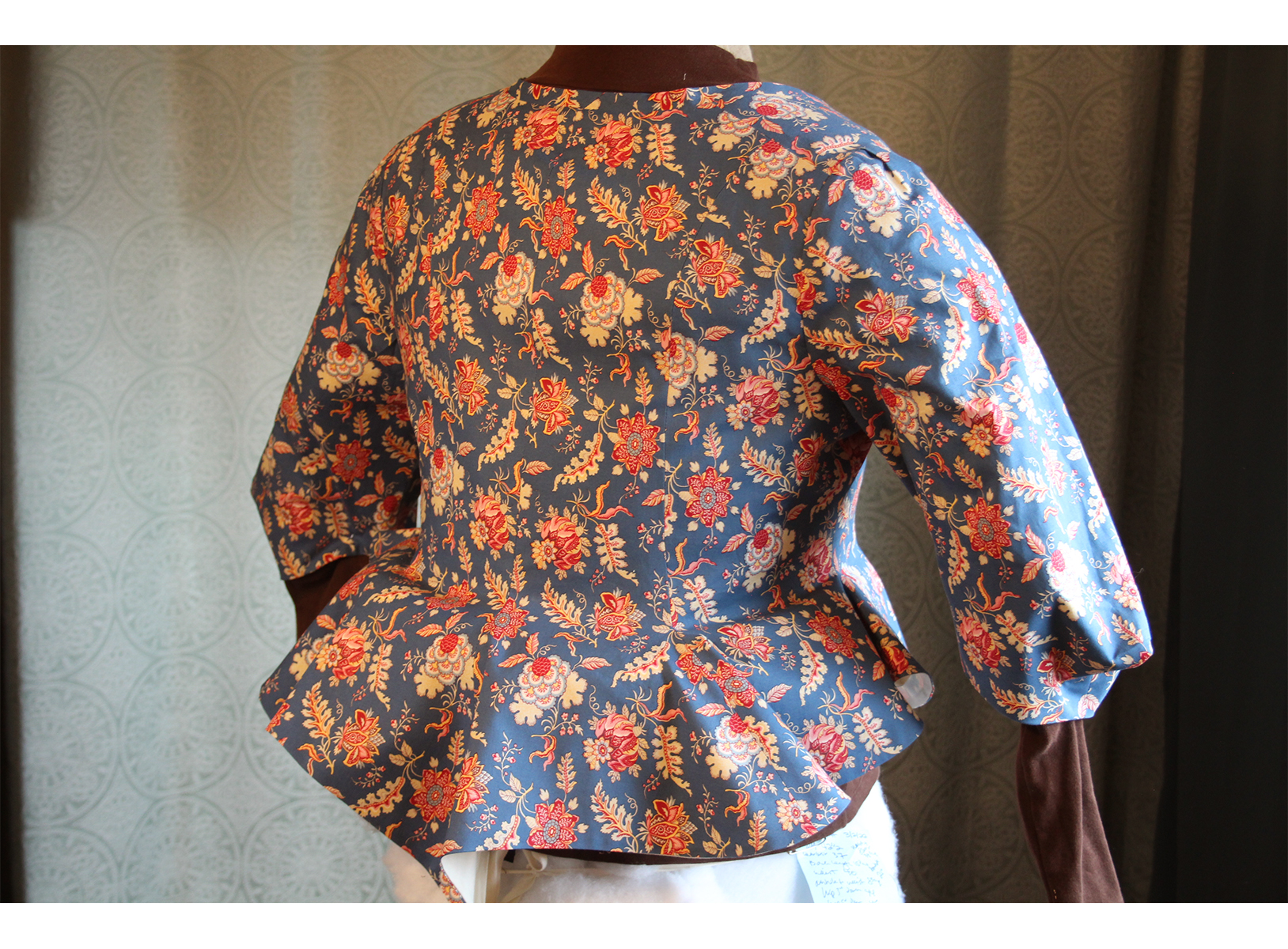
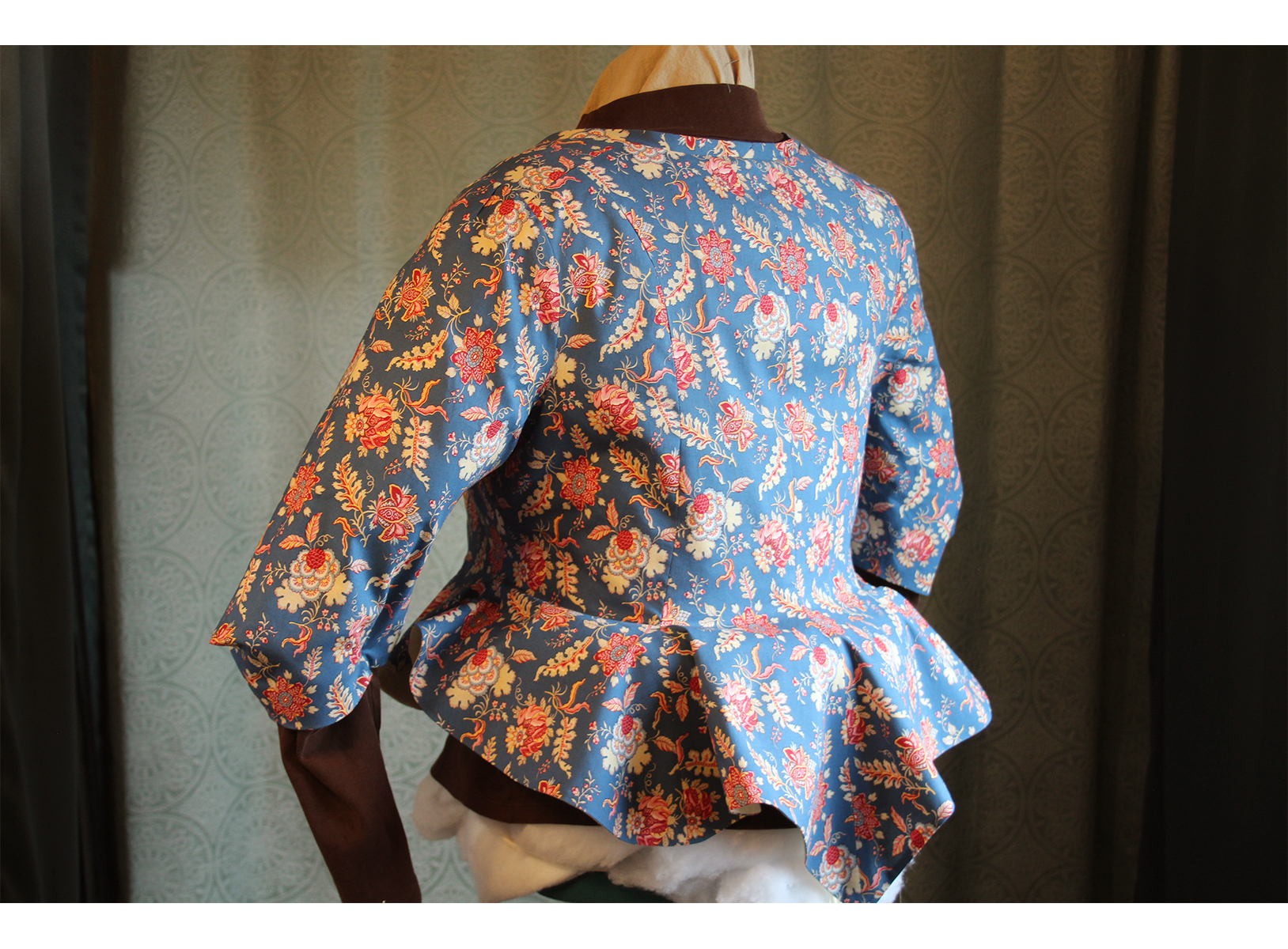
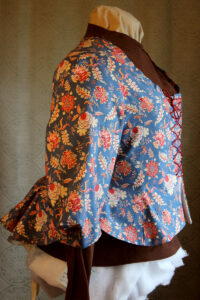
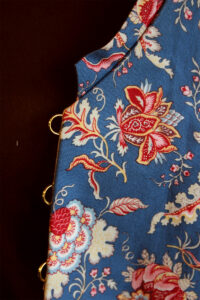
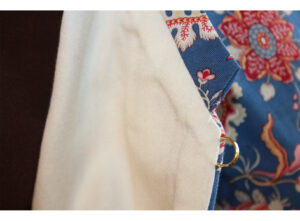
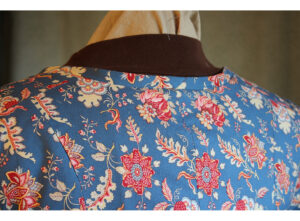
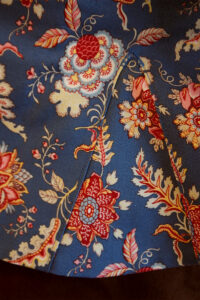
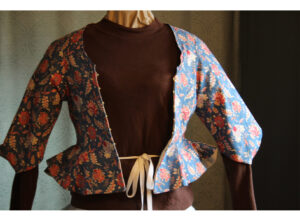
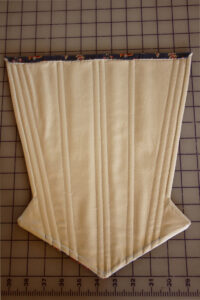
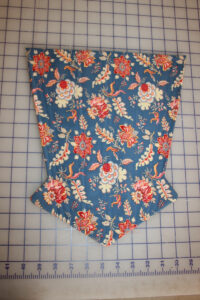
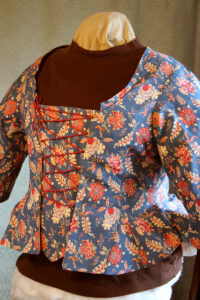
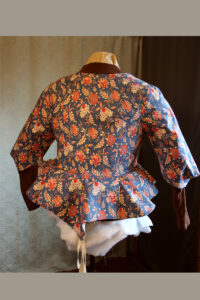
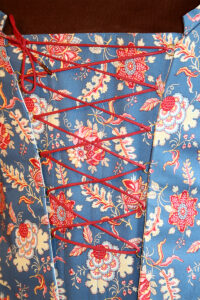
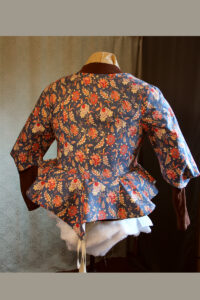
Robe a l’anglaise (English Gown)
with Grande Paniers, Stomacher, and 2 Petticoats
Susan provided the fabric for this one. It was difficult to work with because it was sheeting. In the 18th century fabric came in 22″ and 26″ widths, so designs are draped in panels. I had to recreate panels and do a lot of ironing and squaring up. The floral is one side of the duvet, and the stripe the other. This turned out well though when we added a richer 100% silk petticoat and elaborate ornamentation that is absolutely historically accurate.
All but 8 seams were done by hand equaling over 100 hours total for the items below:
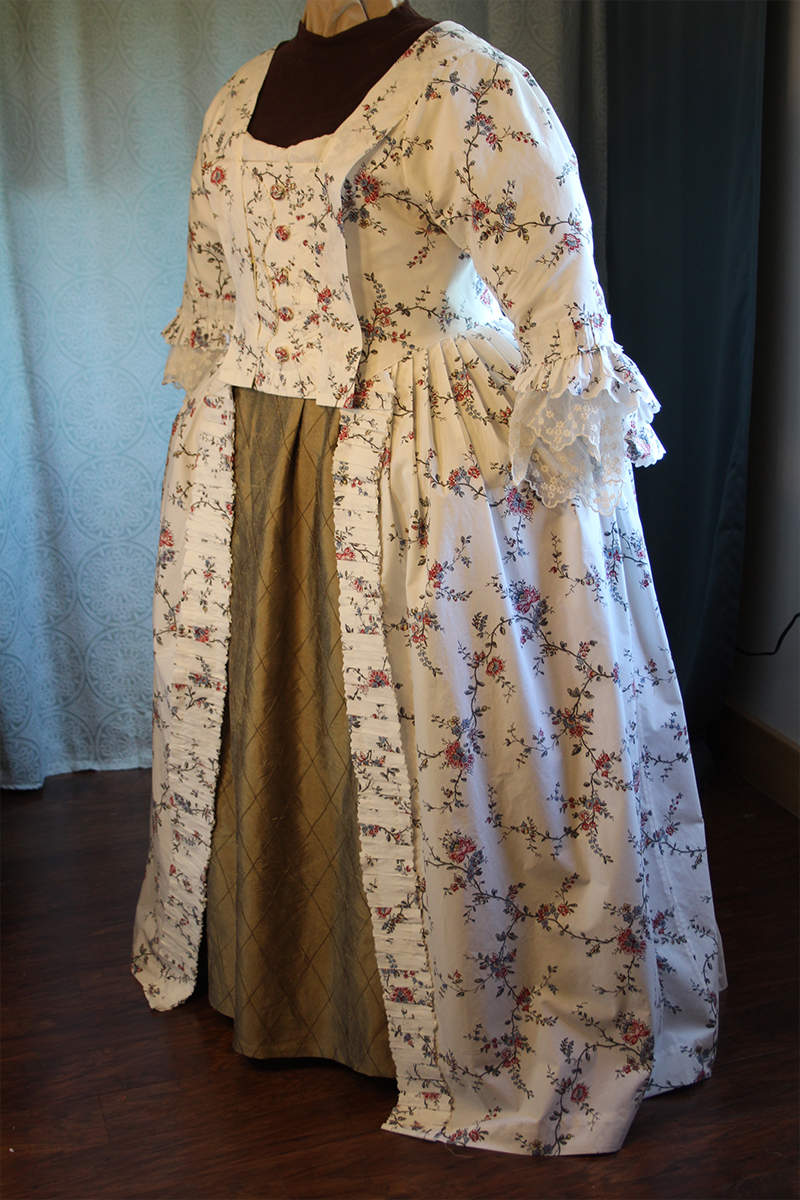
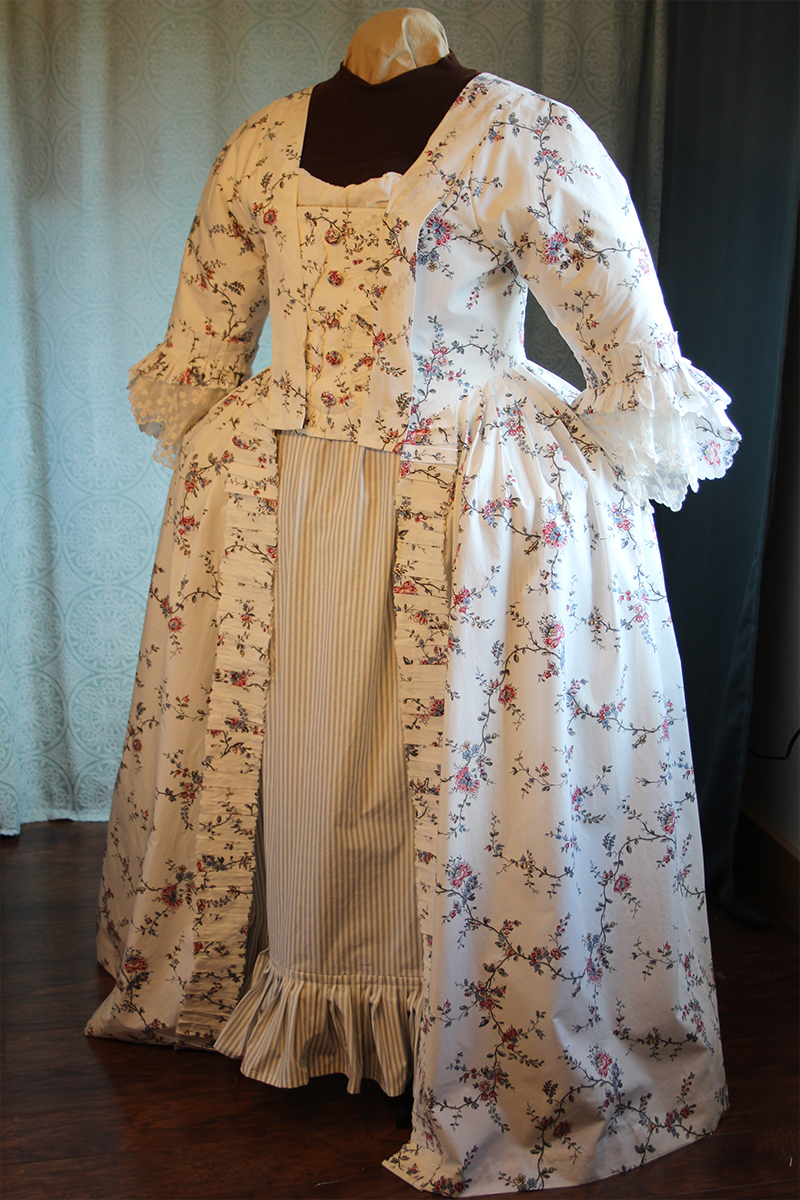
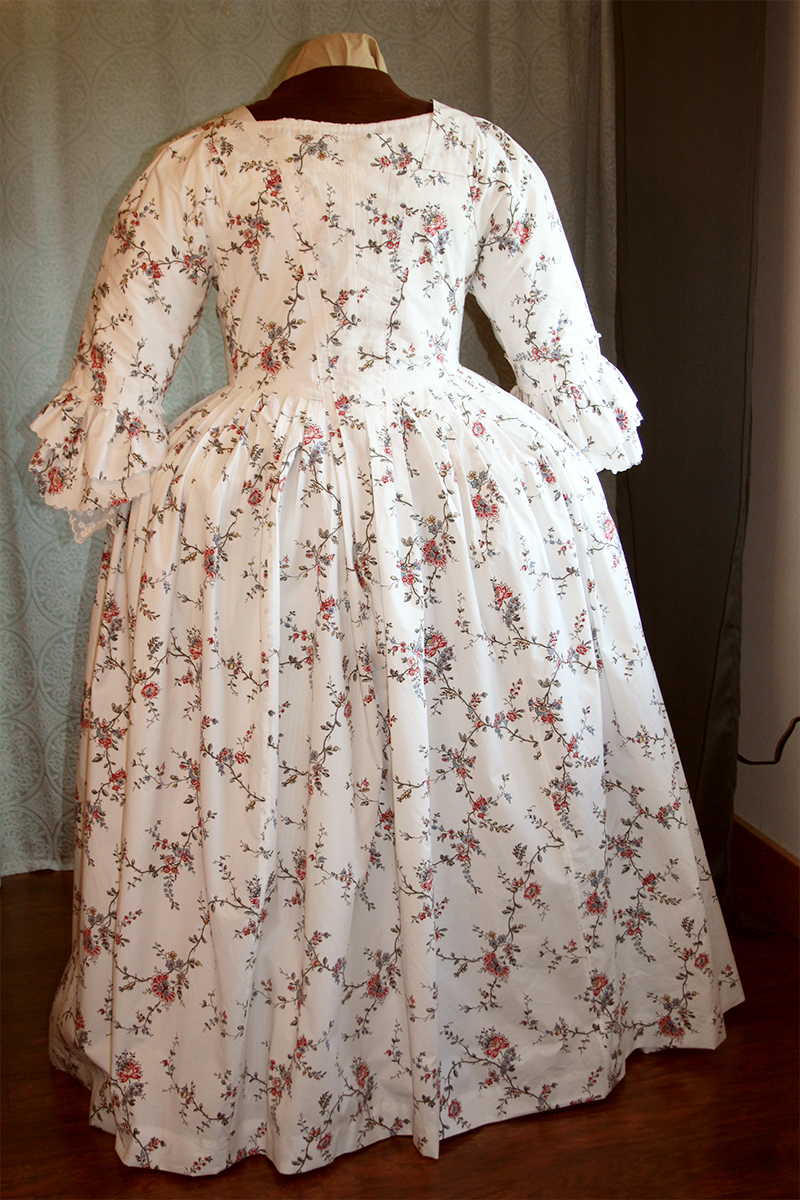
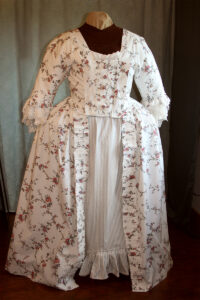
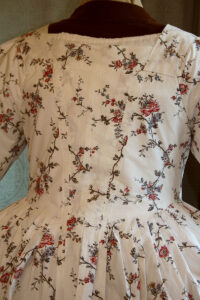
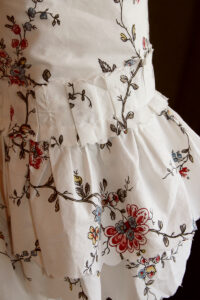
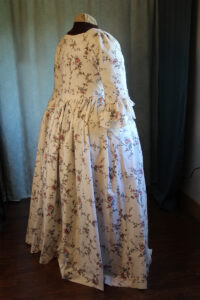
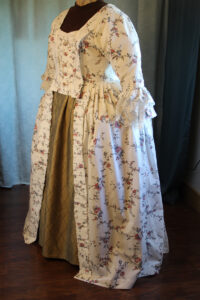
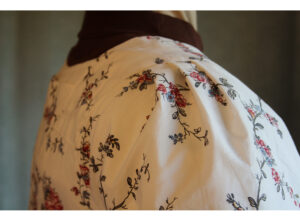
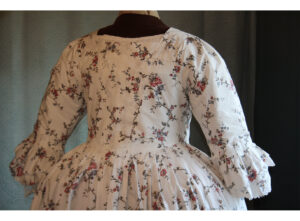
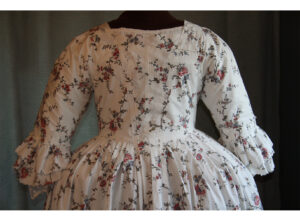
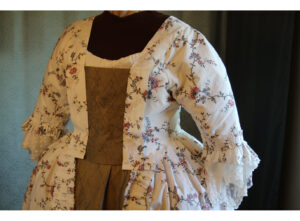
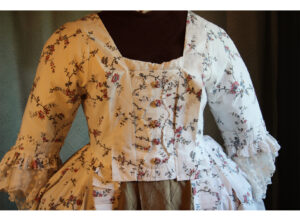
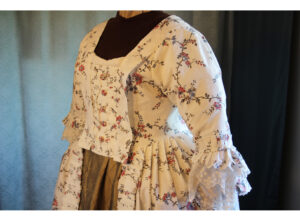
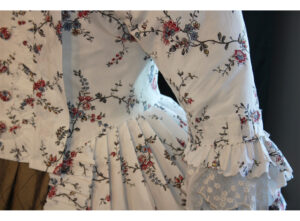
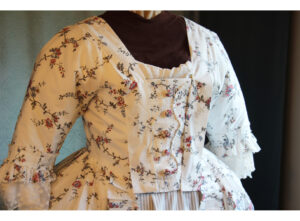
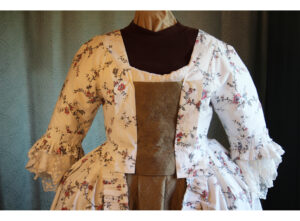
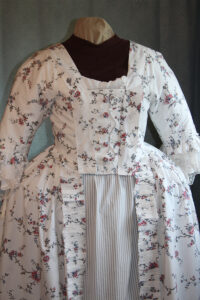
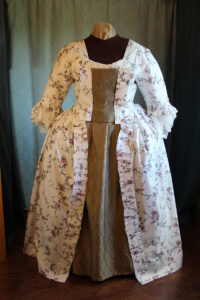
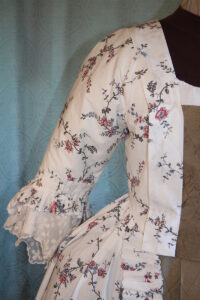
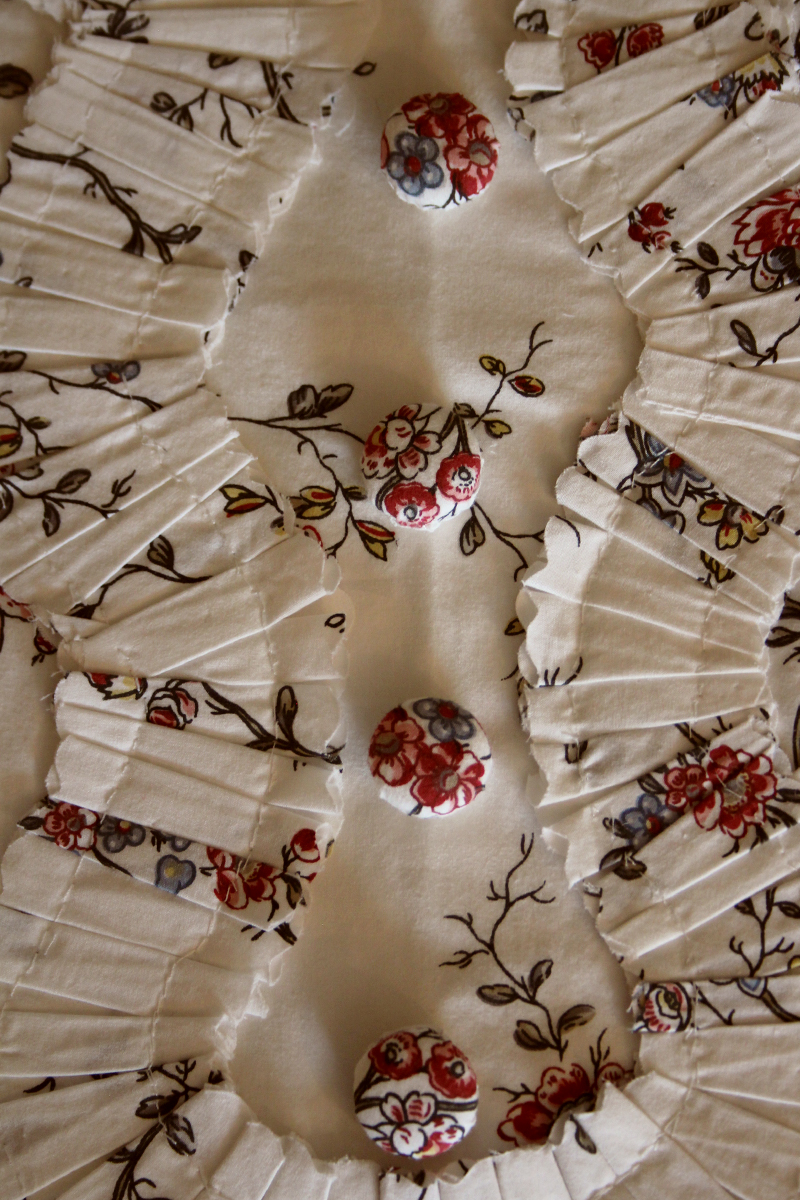
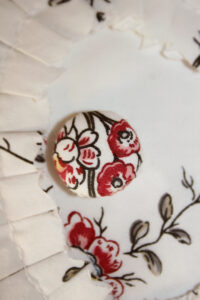
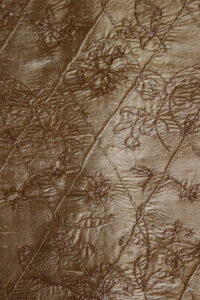
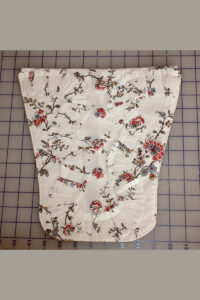
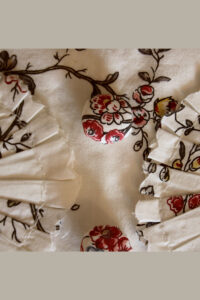
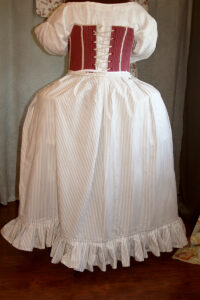
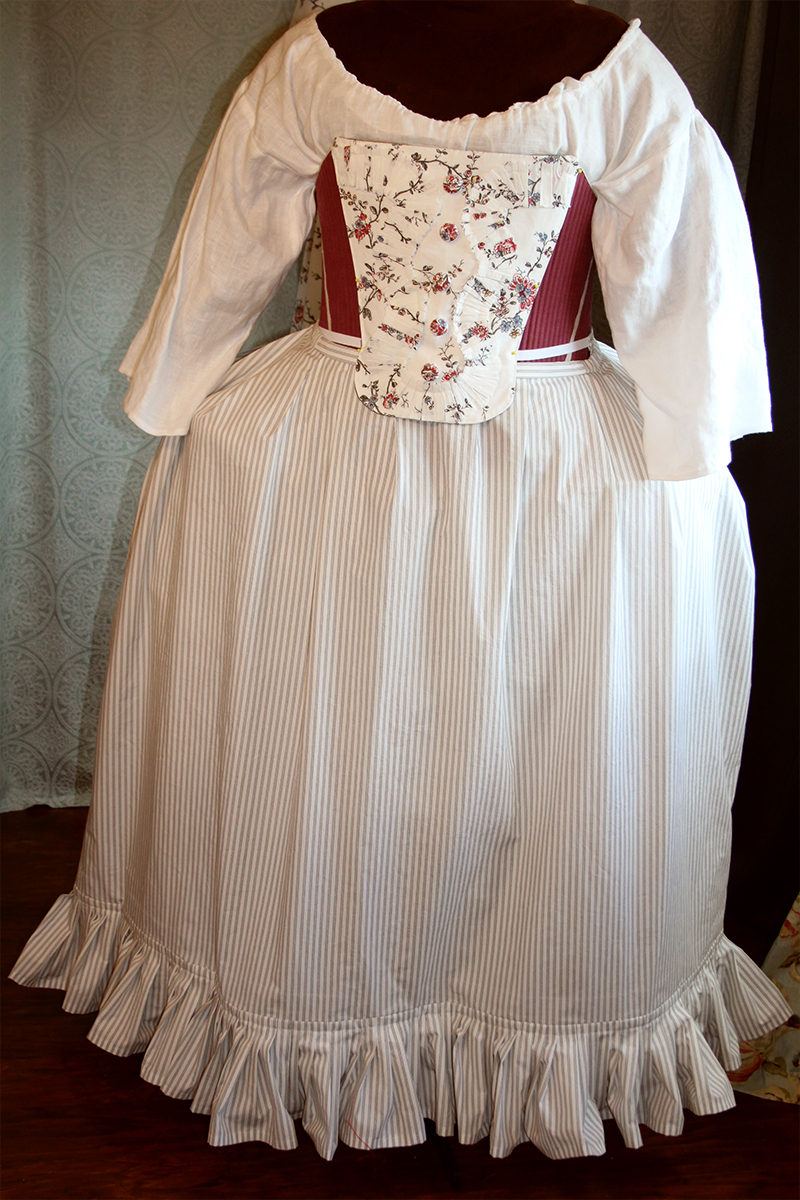
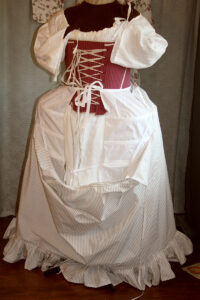
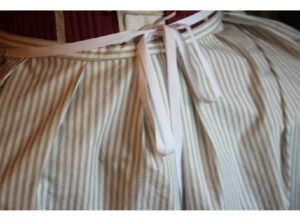
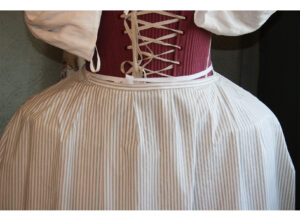
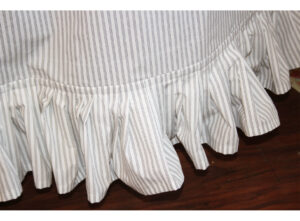
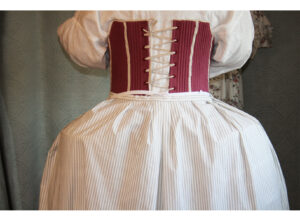
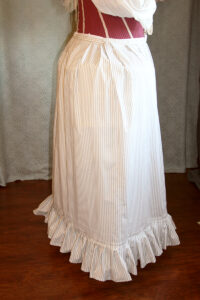
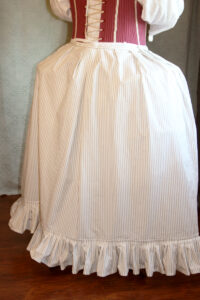
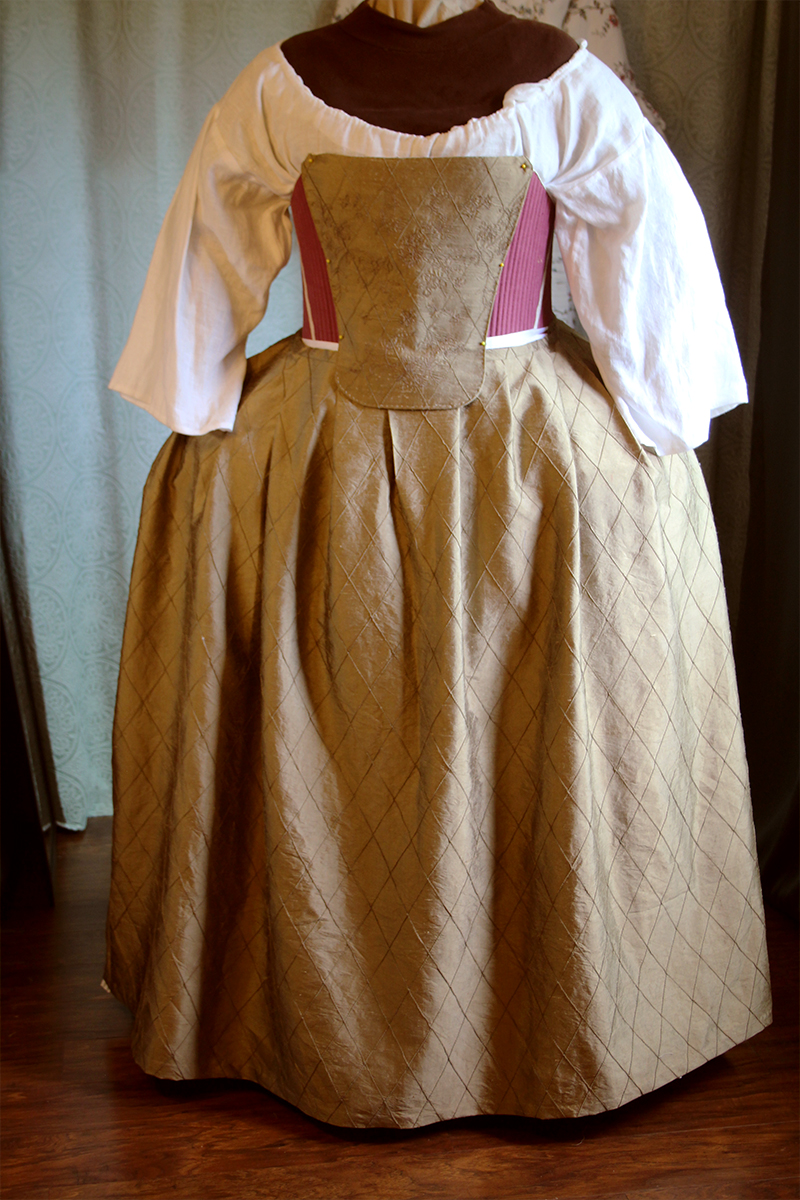
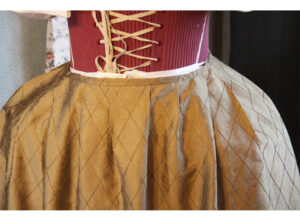
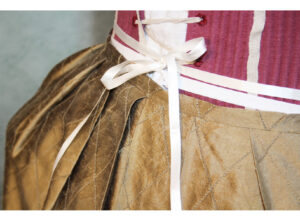
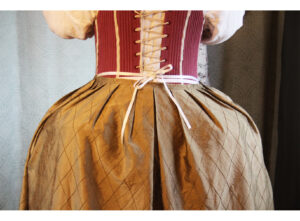
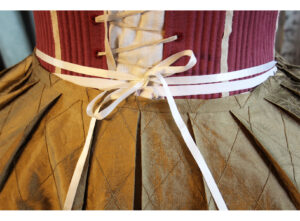
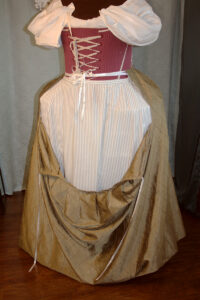
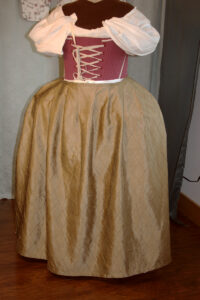
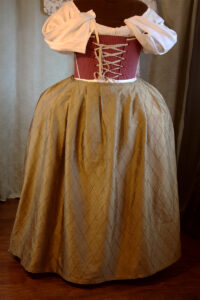
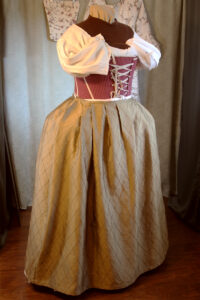
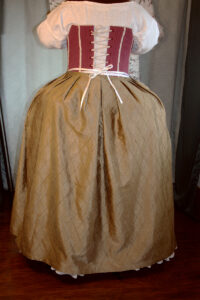
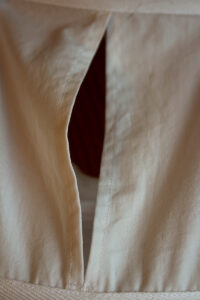
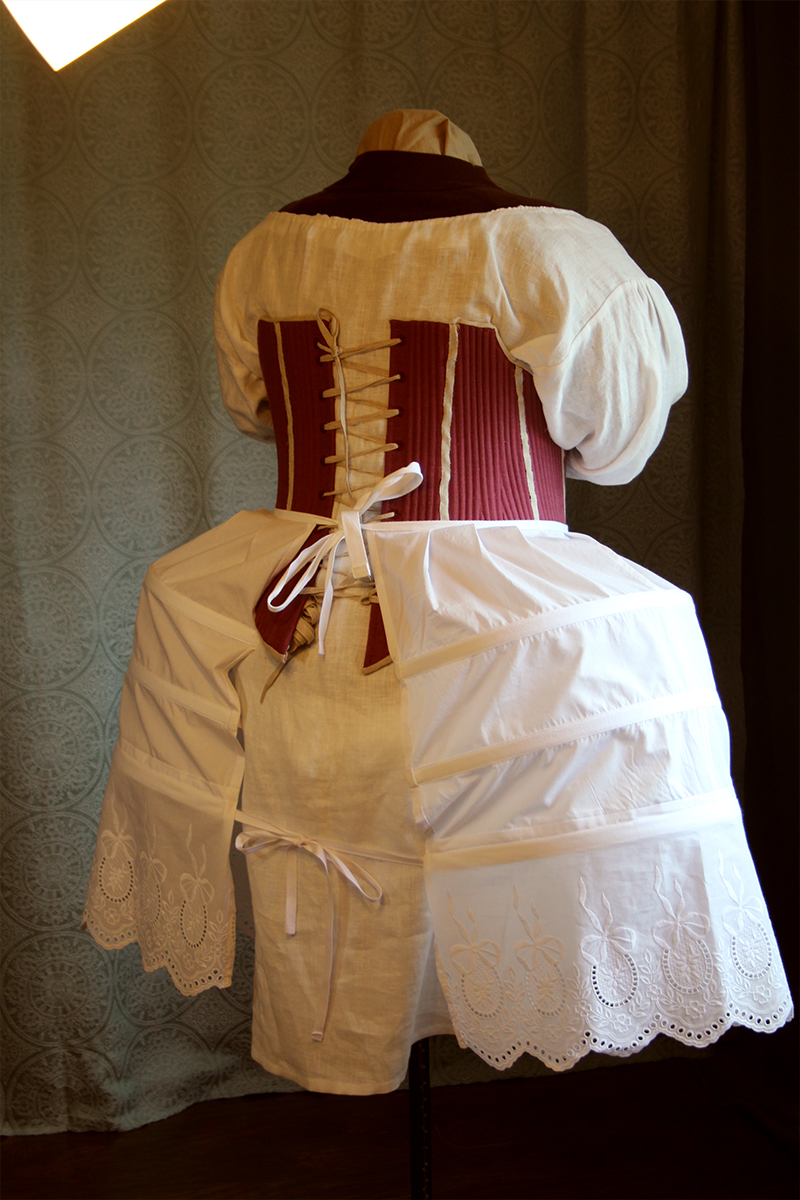
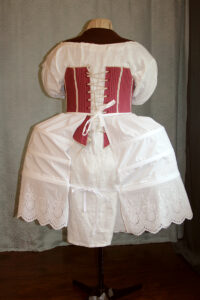
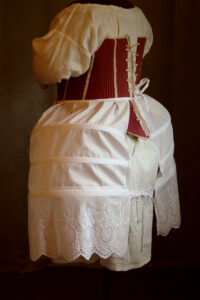
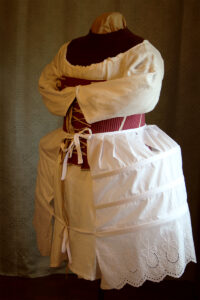
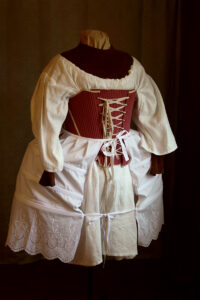
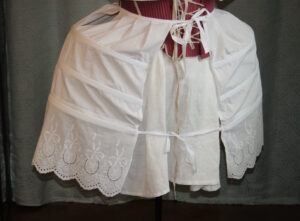
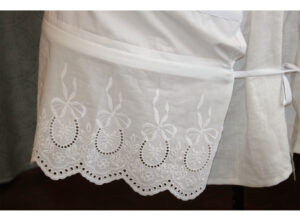
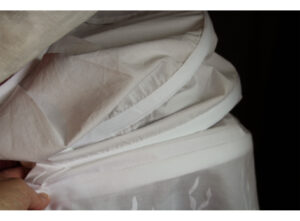
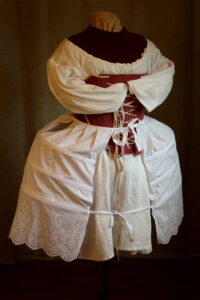
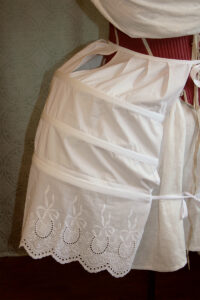
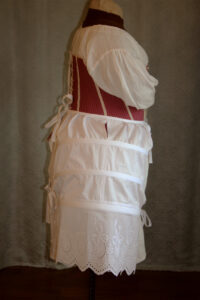
Construction outtakes
